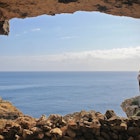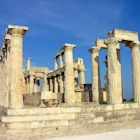
Like nowhere else: Greece’s natural Northern Aegean Islands
Sponsored by
Jul 12, 2023 • 6 min read

Away from the crowds and busy tourist magnets, the Northern Aegean islands of Greece are natural wonders © Getty Images
For decades, the most popular Greek islands have attracted thousands of visitors drawn to the immaculate beauty, the rich history, and the infinite blue of the Aegean sea and sky. But other destinations have remained under the radar – cherished privileges for the Greeks and well-kept secrets for savvy travelers.
Away from the crowds and busy tourist magnets, the Northern Aegean islands offer undisturbed natural splendor, scenic towns and villages, and beautiful, uncrowded beaches. It’s time to discover them, and the pleasures they hide.

Thasos: an emerald paradise steeped in history
You’re bound to be captivated by the natural beauty, the rich history, the numerous antiquities, and the countless old churches and monasteries of this northernmost Aegean island. Pine forests and olive trees descend from the rocky landscape to the water’s edge along the island’s perimeter road.
Limenas, the port, and Panagiá, away from the coast, are picturesque villages with representative Greek architecture and culture. Every type of beach imaginable can be enjoyed here. You’ll be spoiled for choice among shallow waters with golden sand and pine trees, small bays, and spotlessly clean pebbly shores.

Limnos: volcanic landscapes and warm hospitality
Hephaestus is the ancient god of the forge, and his furnace was said to be the core of the earth itself. His island boasts a distinctive geography shaped by ancient volcanic eruptions and a long, curly coastline with splendid beaches, caves, rock formations, dunes, and crystalline waters.
The island is scattered with beautiful stone villages, lakes and wetlands, ancient theaters, temples, and windmills. The warm and welcoming locals, the preserved traditional character, and the celebrated local cuisine, make a holiday in Limnos a thoroughly fulfilling experience.
Myrina, the island’s principal port and administrative capital, stretches across two bays and has an old-world allure with neoclassical mansions and a magnificent Venetian palace, the largest in the Aegean.

Samothraki: a mysterious and rustic fairyland
Samothraki is a remote and mountainous island, undiscovered by the masses but loved by adventurers – with wild nature, beautiful lakes, rivers, and footpaths leading deep into the thick forests.
Mount Saos, at a height of 1600m (5,250ft), is the defining landmark of the island, with oak, cedar, and chestnut trees thriving on its slopes. As you venture through these magical woods you might not encounter druids and nymphs, but you can plunge into the clear streams that create waterfalls and stone basins – the amazing natural swimming pools locally known as vathres.
The island’s wetlands, where migratory birds flock, and its rugged beaches and geothermal springs, complete the striking topography. Finally, Chora’s charming cobblestone alleys and the old castle looming above add to the charm and cultural appeal.

Lesvos: large-scale, low-key
With its pleasant Mediterranean climate, abundant flora and wildlife, unending olive groves, and relaxed lifestyle, Greece’s third-biggest island provides an understated alternative to some of the more touristed destinations. The island’s quaint villages, verdant landscapes, pine forests and thermal springs hide countless wonders waiting to be discovered.
The capital, Mytilene, is a nice blend of traditional and modern architecture, boasting a vibrant harbour and narrow streets lined with cafes and shops. The ancient ruins of Eressos, the famous Petrified Forest, and Molyvos village, with its old stone houses with red roof tiles and a well-preserved imposing castle, are must-visit attractions.
Lesvos, with its varied ecosystem, is a birdwatcher’s paradise as it attracts numerous migratory bird species, while its culinary scene is a real treat for food aficionados. Add to all this the hundreds of diverse beaches, ranging from bustling and cosmopolitan to hidden and deserted, and you have everything you can expect for a perfect holiday.

Chios: mastic trees and scenic villages
Said to be the birthplace of Homer, Chios is one of the least-explored Greek islands, as its traditionally seafaring population has consciously resisted the mass tourism development of other places.
The island is known as the exclusive source of mastic, the precious, fragrant resin of the mastic trees that grow around the southern part of the island. The unique Chios Mastic Museum tells the extraordinary story of this local treasure. With a rich history reflected in its fortress-like medieval villages, distinctive architecture, maze-like cobblestone alleys, and attractions such as the Byzantine Museum and Nea Moni, the island is a splendid cultural hub worth exploring.
Chios also has an array of beautiful and diverse beaches for those seeking a relaxing stay. Black-pebbled Mavra Volia, tranquil Trachili, remote Agia Dynami, and cosmopolitan Karfas are only a few of our favorites.

Samos: ancient heritage and prolific greenery
Philosopher Epicurus and mathematician Pythagoras’ called Samos home. This island, with its lush landscape, green mountains, caves, and gorges, also has a rich cultural heritage and historical significance.
The UNESCO-listed ancient city of Pythagoreion and the Temple of Hera (born in Samos according to Greek mythology) are among the most significant archaeological sites in Greece. Action-looking visitors can hike up Mount Kerkis and explore the Genoan Castle and Tower of Sarakinis, while nature buffs can indulge in birdwatching at Alyki Wetland or Glyfada Lake and explore the magnificent Karlovasi waterfalls.
Samos combines full beaches and vibrant nightlife with serene retreats ideal for relaxation and unwinding.

Ikaria: secrets for a long, carefree life
Ikaria is a Greek island like no other, as the ultra-relaxed and laid-back lifestyle of the locals results in one of the longest life expectancies in the world. Its name derives from the Greek mythological story of Ikarus, and the island is known for its lively summer festivals.
The village of Christos Rachon is famous for the peculiar life schedule of the locals: deserted during the day, it comes to life after sunset with shops, cafes, etc., staying open all night. The island’s diverse coastline with white stone shores, caves, and rock formations, its sandy beaches with turquoise waters, and the towering mountains with impressive canyons and lush hillsides comprise an extraordinary terrain for nature lovers and adventurers.

Small is beautiful: The best of the rest
On other, smaller, islands – gorgeous but unaffected by mass tourism – you’ll feel as if time stopped decades ago. Family fish tavernas and a few shops providing basic wares are the only commercial encounters on these mainly fishing and beekeeping paradises.
Agios Efstratios (Ai Stratis) was a place of exile for political opponents during the country’s turbulent years. Fournoi and the even smaller Thymaina are the only inhabited rocky islets between Samos and Ikaria. Oinousses, wealthy and cosmopolitan, with a long naval tradition, is a tranquil summer retreat for wealthy Greek shipowners. And Psara has a weighty history going back to the Greek War of Independence. These are the Aegean’s petite delights, perfect for sophisticated travelers looking for the ultimate escape.
All feature solitary and immaculate beaches, virgin natural beauty, and a rocky terrain carved by the salty Aegean waters and swept by the north winds. An ideal choice if you’re longing for calmness, seclusion, and glorious starry nights like nowhere else in the world.
Sponsored by Greek National Tourism Organisation
As a travel entertainment and inspirational media outlet, we sometimes incorporate brand sponsors into our efforts. This activity is clearly labeled across our platforms.
This story was crafted collaboratively between Greek National Tourism Organisation and Lonely Planet. Both parties provided research and curated content to produce this story. We disclose when information isn’t ours.
With sponsored content, both Lonely Planet and our brand partners have specific responsibilities:
Brand partner
Determines the concept, provides briefing, research material, and may provide feedback.
Lonely Planet
We provide expertise, firsthand insights, and verify with third-party sources when needed.
Explore related stories

Shopping
What to buy in a Greek supermarket: from tzatziki to oregano chips and moreSep 16, 2024 • 7 min read








